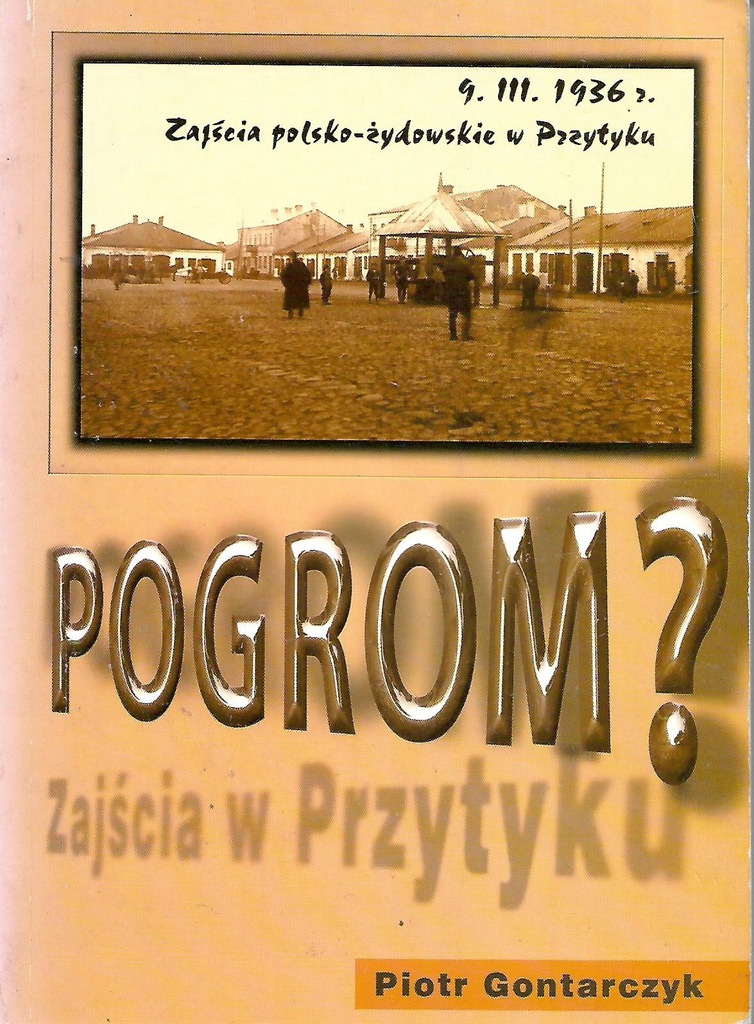Przytyk Pogrom Jews First Resorted to Murder Gontarczyk

Pogrom? Zajscia Polsko-Zydowski w Przytyku 9 Marca 1936, by Piotr Gontarczk. 2000
The Przytyk Pogrom: What Actually Happened? First and Foremost a Homicidal Jewish Riot
The English-language title of this book is: Pogrom? The Polish-Jewish Incident at Przytyk on March 9, 1936. Myths, Facts, and Documents. It contains an English summary (pp. 369-372). Przytyk needs re-evaluation because of the anti-Polish biases surrounding it, as, for example, exhibited by Celia Heller’s ON THE EDGE OF DESTRUCTION (p. 19).
Because Gontarczyk doesn’t follow the conventional Pole-bashing approach, he has been labeled an ethno-nationalist. In actuality, he faults the National Democrats (Endeks) a number of times, as for making gratuitous anti-Semitic remarks (p. 93).
JEWISH-POLISH ECONOMIC RIVALRY AS BACKDROP TO THE POGROM
At Przytyk, the peasants believed that Jewish merchants were systematically cheating them (p. 47) and, besides pressing their advantage of experience in commerce, were also using various underhanded methods to drive peasant merchants out of business (p. 49). To level the playing field (my term), the Poles decided to buy only from Polish merchants. Unlike the situation in many other areas of Poland, the boycotts of Jewish merchants actually grew in popularity and became self-sustaining.
Tensions grew especially acute in the market square. In the months before the pogrom, there were a series of minor, disconnected, violent incidents (pp. 53-54)–some Jews against Poles (as in attempting to break the boycott) and some vice-versa. These, however, didn’t escalate into anything bigger.
IT WAS THE JEWS THAT ESCALATED MINOR, INDIVIDUAL ACTS OF VIOLENCE INTO MASS VIOLENCE
One day, they finally did. On that fateful day, Jewish merchants overturned and damaged “interloper” Joseph Gniazdka’s booth, and assaulted boycott-advocate Joseph Stzalkowski, who hit back (p. 59). Later, three peasants assaulted Moszek Dalman and a few other Jewish merchants, upsetting their carts and scattering their wares (p. 61). Soon thereafter, the SELBSCHUTZ (Jewish “self-defense” unit) swung into action. It attacked not only the three Poles who had assaulted Dalman et al., but also other Poles who had nothing to do with the initial anti-Jewish assault (p. 135). Some of the SELBSCHUTZ members were armed, and began to shoot not at the Polish assailants, but at Poles indiscriminately. A number of Poles were wounded by the Jewish snipers, and Stanislaw Wiesniak was killed (p. 65). A Polish mob began to grow and, enraged by the murder of Wiesniak, began an indiscriminate retaliatory attack against Jews and their properties. Two Jews (the Minkowskis) were killed and scores of properties destroyed or damaged. The Polish police were helpless in the face of the size of the mob.
IT WAS THE JEWISH SIDE THAT INTRODUCED DEADLY FORCE INTO A HITHERTO-NONLETHAL CONFLICT
The so-called Przytyk Pogrom was a Jewish riot before it also became a Polish riot. Clearly, it was the Jewish side that was responsible for escalating the violence from a trivial incident to a full-scale melee, for unilaterally bringing firearms to the conflict (p. 96), and especially for introducing mass collective ethnic revenge into the picture.
THE POLISH COURTS DEAL WITH THE POGROM
Each side asserted that the Polish courts had been more lenient to the other. Gontarczyk contends that the disparity in sentencing stemmed from the fact that the evidence implicating specific Jewish killers was stronger than that against accused Polish killers (pp. 130-131). Also, the killing of Wiesniak was an act of premeditated murder, whereas that of the Minkowskis was more of a retaliatory crime of passion (p. 109).
There is no evidence that the Endeks, or anyone else, had orchestrated the events at Przytyk (pp. 369-370). And, ironic to the charge that Polish police sided with pogromists (passively or actively), peasants believed the exact opposite, at times rioting against police for defending Jews (p. 52, 370).
THE WEST’S MAINSTREAM MEDIA—THEN AND NOW—BLAMED EVERYTHING ON THE POLES
All along, the Jewish press worldwide had been painting lurid pictures of Poland as an unusually violent, anti-Semitic nation (sounds familiar?). For this purpose, Jewish violence against Poles was virtually ignored, the handful of Jews killed was embellished into 80 (p. 86) and a few broken windows became hundreds (p. 43). The bombing of a synagogue was attributed to Poles even though the perpetrator was a Jew (p. 42). There were even fantastic tales, which anticipated certain aspects of later post-Holocaust German-whitewashing Polonophobia, of the Poles being out to exterminate all the Jews! (p. 83).
To see a series of truncated reviews in a Category click on that Category:
- All reviews
- Anti-Christian Tendencies
- Anti-Polish Trends
- Censorship on Poles and Jews
- Communization of Poland
- Cultural Marxism
- German Guilt Dilution
- Holocaust Industry
- Interwar Polish-Jewish Relations
- Jewish Collaboration
- Jewish Economic Dominance
- Jews Antagonize Poland
- Jews Not Faultless
- Jews' Holocaust Dominates
- Jews' Holocaust Non-Special
- Nazi Crimes and Communist Crimes Were Equal
- Opinion-Forming Anti-Polonism
- Pogrom Mongering
- Poland in World War II
- Polish Jew-Rescue Ingratitude
- Polish Nationalism
- Polish Non-Complicity
- Polish-Ukrainian Relations
- Polokaust
- Premodern Poland
- Recent Polish-Jewish Relations
- The Decadent West
- The Jew as Other
- Understanding Nazi Germany
- Why Jews a "Problem"
- Zydokomuna